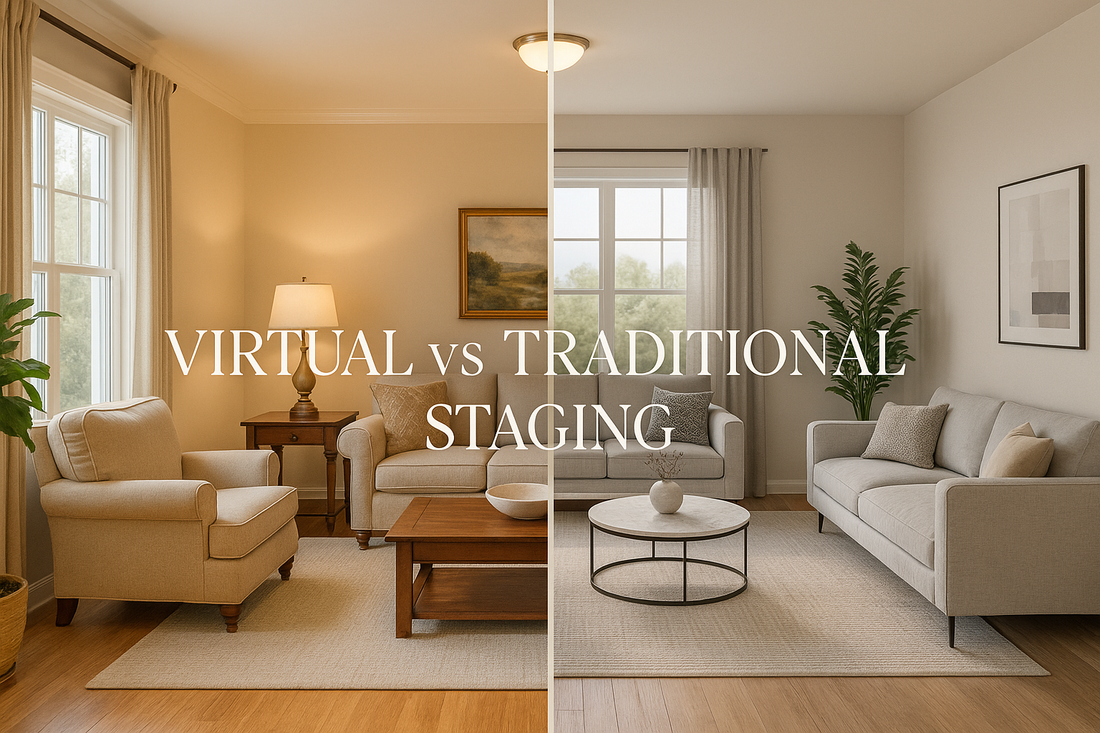
Virtual Staging vs. Traditional Staging: Which Drives More Sales?
Share
Virtual Staging vs. Traditional Staging: Which Drives More Sales?
In the competitive world of real estate, presentation is everything. Buyers today make quick decisions, often within seconds of scrolling through property listings online. That’s where staging comes into play. Staging helps transform an empty or outdated property into a space that sparks imagination, allowing potential buyers to see its true potential. But in recent years, real estate professionals have been asking: should I choose traditional staging or virtual staging to attract more buyers? Let’s explore both approaches and uncover which one truly drives more sales.
What is Traditional Staging?
Traditional staging involves physically furnishing and decorating a property before putting it on the market. Professional stagers bring in rental furniture, artwork, and décor to make each room appealing. This method has been used for decades, and it helps create a welcoming atmosphere during open houses and in listing photos.
Advantages of Traditional Staging:
-
Gives buyers a real-life experience during property visits.
-
Enhances emotional connection as visitors can physically walk through styled rooms.
-
Works well for luxury homes where high-end finishes and tactile experiences matter.
Challenges of Traditional Staging:
-
It can be very expensive, often costing thousands of dollars depending on the size of the home.
-
The process is time-consuming—arranging, moving, and styling furniture takes days.
-
Limited flexibility—once staged, you cannot easily change styles or layouts.
What is Virtual Staging?
Virtual staging uses digital technology to design and furnish empty rooms. Skilled designers take professional photos of a property and add realistic furniture, lighting, and décor using 3D software. The final results are photorealistic images that can be used in online listings, brochures, and advertisements.
Advantages of Virtual Staging:
-
Significantly more affordable than traditional staging.
-
Quick turnaround time—most projects can be completed in 24–48 hours.
-
Unlimited flexibility—furniture, wall colors, and styles can be changed instantly to appeal to different buyer preferences.
-
Perfect for online-first buyers, especially in today’s digital marketplace.
Challenges of Virtual Staging:
-
Buyers may feel disappointed if they expect the property to look exactly like the staged photos.
-
Virtual staging cannot provide the same physical walk-through experience as traditional staging.
-
Requires transparency—agents must disclose that the images are virtually staged to maintain trust.
Which One Drives More Sales?
When comparing both methods, it’s clear that virtual staging and traditional staging serve slightly different purposes, but both aim to shorten selling time and increase sale prices.
-
Impact on Online Listings

-
With more than 90% of buyers starting their home search online, virtual staging often wins in this area. It makes empty or outdated properties look modern, spacious, and ready for move-in. Listings with virtually staged photos tend to receive more clicks and generate higher interest compared to plain photos.
-
-
Impact on Physical Showings
-
Traditional staging shines when buyers visit in person. Walking through a beautifully decorated space can help buyers imagine their lifestyle in the home and trigger emotional attachment.
-
-
Cost vs. Return on Investment
-
Virtual staging usually costs just a fraction of traditional staging but still has the power to boost buyer interest. This makes it particularly effective for budget-conscious sellers or agents managing multiple listings.
-
-
Market Trends
-
In today’s fast-moving real estate market, especially with the rise of remote and international buyers, virtual staging is becoming the go-to solution. It enables properties to stand out online, where the majority of first impressions are made.
-
The Smart Approach: A Hybrid Model
The most effective strategy may be to combine both methods. For example, agents can use virtual staging to create compelling online listings and attract buyers, then complement it with traditional staging in key spaces like the living room or master bedroom during open houses. This hybrid approach balances cost, flexibility, and buyer experience.
Final Thoughts
So, which drives more sales—virtual staging or traditional staging? The answer depends on your target market and budget. Traditional staging still plays a powerful role in luxury and high-value homes where in-person experiences matter most. However, virtual staging has quickly proven itself as a cost-effective, flexible, and highly impactful tool in today’s digital-first real estate market.
At the end of the day, the goal is the same: to help buyers connect with a property emotionally and envision it as their future home. Whether through virtual or traditional means, the right staging strategy can make all the difference in closing a successful sale.
